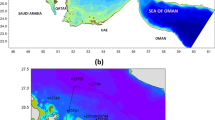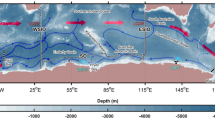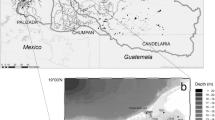Abstract
Shallow estuarine lagoons characterize >70 % of the eastern Alaskan Beaufort Sea coastline and, like temperate and tropical lagoons, support diverse and productive biological communities. These lagoons experience large variations in temperature (−2 to 14 °C) and salinity (0 to >45) throughout the year. Unlike lower latitude coastal systems, transitions between seasons are physically extreme and event-driven. On Arctic coastlines, a brief summer open-water period is followed by a 9-month ice-covered period that concludes with a late-spring sea ice breakup and intense freshwater run-off. From 2011 to 2014, we examined interannual variations in water column physical structure (temperature, salinity, and δ18O) in five lagoons that differ with respect to their degree of exchange with adjacent marine waters and magnitude of freshwater inputs. Temperature, salinity, and source water composition (calculated using a salinity and δ18O mixing model) were variable in space and time. During sea ice breakup in June, water column δ18O and salinity measurements showed that low salinity waters originated from meteoric inputs (50–80 %; which include river inputs and direct precipitation) and sea ice melt (18–51 %). Following breakup, polar marine waters became prevalent within a mixed water column over the summer open-water period within all five lagoons (26–63 %). At the peak of ice-cover extent and thickness in April, marine water sources dominated (75–87 %) and hypersaline conditions developed in some lagoons. Seasonal runoff dynamics and differences in lagoon geomorphology (i.e., connectivity to the Beaufort Sea) are considered key potential drivers of observed salinity and source water variations.







Similar content being viewed by others
References
Alkire, M.B., and J.H. Trefry. 2006. Transport of spring floodwater from rivers under ice to the Alaskan Beaufort Sea. Journal of Geophysical Research 111: C12008.
Barry, R.G., R.E. Moritz, and J.C. Rogers. 1979. The fast ice regimes of the Beaufort and Chukchi Sea coasts, Alaska. Cold Regions Science and Technology 1: 129–152.
Brown, S.C. 2006. Arctic Wings: birds of the Arctic national wildlife refuge. Seattle: Mountaineers Books.
Carmack, E., and P. Wassmann. 2006. Food webs and physical-biological coupling on pan-Arctic shelves: unifying concepts and comprehensive perspectives. Progress in Oceanography 71: 446–477.
Chapin, F.S. 2005. Role of land-surface changes in arctic summer warming. Science 310: 657–660.
Cooper, L.W. 1998. Isotopic fractionation in snow cover. In Isotope tracers in catchment hydrology, eds. C. Kendall and J.J. McDonnell, 839. Amsterdam: Elsevier.
Cooper, L.W., T.E. Whitledge, J.M. Grebmeier, and T. Weingartner. 1997. The nutrient, salinity, and stable oxygen isotope composition of Bering and Chukchi seas waters in and near the Bering Strait. Journal of Geophysical Research 102: 12563.
Cooper, L.W., R. Benner, J.W. McClelland, B.J. Peterson, R.M. Holmes, P.A. Raymond, D.A. Hansell, J.M. Grebmeier, L.A. Codispoti, J.J. Gibson, C.K. Guay, and B.J. Peterson. 2005. Flow-weighted values of runoff tracers (d18O, DOC, Ba, alkalinity) from the six largest Arctic rivers. Journal of Geophysical Research 35: 1–5.
Cooper, L.W., J.W. McClelland, R.M. Holmes, P.A. Raymond, J.J. Gibson, C.K. Guay, and B.J. Peterson. 2008. Flow-weighted values of runoff tracers (d18O, DOC, Ba, alkalinity) from the six largest Arctic rivers. Geophysical Research Letters 35: 3–7.
Dimova, N.T., A. Paytan, J.D. Kessler, K.J. Sparrow, F. Garcia-Tigreros Kodovska, A.L. Lecher, J. Murray, and S.M. Tulaczyk. 2015. Current magnitude and mechanisms of groundwater discharge in the Arctic: case study from Alaska. Environmental Science and Technology 49: 12036–12043.
Dunton, K.H., T. Weingartner, and E.C. Carmack. 2006. The nearshore western Beaufort Sea ecosystem: circulation and importance of terrestrial carbon in arctic coastal food webs. Progress in Oceanography 71: 362–378.
Dunton, K.H., S.V. Schonberg, and L.W. Cooper. 2012. Food web structure of the Alaskan nearshore shelf and estuarine lagoons of the Beaufort Sea. Estuaries and Coasts 35: 416–435.
Eicken, H., H.R. Krouse, D. Kadko, and D.K. Perovich. 2002. Tracer studies of pathways and rates of meltwater transport through Arctic summer sea ice. Journal of Geophysical Research, Oceans 107: SHE 22–1–SHE 22–20.
Hale, D.A. (NOAA). 1990. A description of the physical characteristics of nearshore and lagoonal waters in the eastern Beaufort Sea, 1988. Anchorage, Alaska.
Hale, D.A (NOAA). 1991. A description of the physical characteristics of nearshore and lagoonal waters in the eastern Beaufort Sea, 1989. Anchorage, Alaska.
Hinzman, L.D., N.D. Bettez, W.R. Bolton, F.S. Chapin, M.B. Dyurgerov, C.L. Fastie, B. Griffith, R.D. Hollister, A. Hope, H.P. Huntington, A.M. Jensen, G.J. Jia, T. Jorgenson, D.L. Kane, D.R. Klein, G. Kofinas, A.H. Lynch, A.H. Lloyd, A.D. McGuire, F.E. Nelson, W.C. Oechel, T.E. Osterkamp, C.H. Racine, V.E. Romanovsky, R.S. Stone, D.A. Stow, M. Sturm, C.E. Tweedie, G.L. Vourlitis, M.D. Walker, D.A. Walker, P.J. Webber, J.M. Welker, K.S. Winker, and K. Yoshikawa. 2005. Evidence and implications of recent climate change in northern Alaska and other arctic regions. Climatic Change 72: 251–298.
Lecher, A.L., J. Kessler, K. Sparrow, F. Garcia-Tigreros Kodovska, N. Dimova, J. Murray, S. Tulaczyk, and A. Paytan. 2015. Methane transport through submarine groundwater discharge to the North Pacific and Arctic Ocean at two Alaskan sites. Limnology and Oceanography. doi:10.1002/lno.10118.
Lissauer, I.M., L.E. Hachmeister, and B.J. Morson. 1984. Atlas of the Beaufort Sea. Coast guard research and development center Groton CT. No. CGR/DC-17/84.
Macdonald, R.W., C.S. Wong, and P.E. Erickson. 1987. The distribution of nutrients in the southeastern Beaufort Sea: implications for water circulation and primary production. Journal of Geophysical Research 92: 2939–2952.
Macdonald, R.W., E.C. Carmack, F.A. McLaughlin, K. Iseki, D.M. Macdonald, and M.C. O’Brien. 1989. Composition and modification of water masses in the Mackenzie shelf estuary. Journal of Geophysical Research, Oceans 94: 18057–18070.
Macdonald, R.W., F.A. McLaughlin, and E.C. Carmack. 2002. Fresh water and its sources during the SHEBA drift in the Canada Basin of the Arctic Ocean. Deep Sea Research Part I: Oceanographic Research Papers 49: 1769–1785.
Matthews, J.B. 1981. Observations of under-ice circulation in a shallow lagoon in the Alaskan Beaufort Sea. Ocean Management 6: 223–234.
Matthews, J.B., and W.J. Stringer. 1984. Spring breakup and flushing of an Arctic lagoon estuary. Journal of Geophysical Research 89: 2073.
McClelland, J.W., S.J. Déry, B.J. Peterson, R.M. Holmes, and E.F. Wood. 2006. A pan-arctic evaluation of changes in river discharge during the latter half of the 20th century. Geophysical Research Letters 33.
McClelland, J.W., R.M. Holmes, K.H. Dunton, and R.W. Macdonald. 2012. The Arctic Ocean estuary. Estuaries and Coasts 35: 353–368.
McClelland, J.W., A. Townsend-Small, R.M. Holmes, F. Pan, M. Stieglitz, M. Khosh, and B.J. Peterson. 2014. River export of nutrients and organic matter from the north slope of Alaska to the Beaufort Sea. Water Resources Research: 1823–1839.
Ostlund, H.G., and G. Hut. 1984. Arctic Ocean water mass balance from isotope data. Journal of Geophysical Research, Oceans 89: 6373–6381.
Peterson, B.J., J. McClelland, R. Curry, R.M. Holmes, J.E. Walsh, and K. Aagaard. 2006. Trajectory shifts in the Arctic and subarctic freshwater cycle. Science (New York, N.Y.) 313: 1061–1066.
Pollard, D.D., and D.A. Segar. 1994. The physical characteristics of nearshore and Lagoonal waters in the Eastern Beaufort Sea, 1990.
Schell, D.M., P.M. Daniel, and P.J. Ziemann. 1984. Chapter 5 primary production, nutrient dynamics, and trophic energetic. Environmental Characterization and Biological use of Lagoons in the Eastern Beaufort Sea: 369–432.
Sellman, P.V., A.J. Delaney, E.J. Chamberlain, K.H. Dunton, C. Regions, and S. Technology. 1992. Seafloor temperature and conductivity data from Stefansson Sound, Alaska. Cold Regions Science and Technology 20: 271–288.
von Biela, V.R., C.E. Zimmerman, and L.L. Moulton. 2011. Long-term increases in young-of-the-year growth of Arctic cisco Coregonus autumnalis and environmental influences. Journal of Fish Biology 78: 39–56.
McCart, P. 1977. Fisheries investigations along the North slope from Prudhoe Bay, Alaska to the Mackenzie Delta, N.W.T.
Yi, Y., J.J. Gibson, L.W. Cooper, J.F. Hélie, S.J. Birks, J.W. McClelland, R.M. Holmes, and B.J. Peterson. 2012. Isotopic signals ( 18O, 2H, 3H) of six major rivers draining the pan-Arctic watershed. Global Biogeochemical Cycles 26.
Acknowledgments
The authors thank the Captains (T. Dunton and J. Dunton) of the R/V Proteus for their invaluable navigation skills and support of our research. We are also very grateful to field assistants R. Thompson, S. Linn, S. Smith, and J. Smith for their long hours and enthusiastic support of this work. This field-intensive campaign would not have been possible without the support of D. Payer and others at the Arctic National Wildlife Refuge and at US Fish and Wildlife Service headquarters in Fairbanks. We would also like to thank K. Jackson (Texas based logistic support), S. Schonberg (assistance with ArcGIS), and M. Otter at the Marine Biological Laboratory (oxygen isotope analysis). Funding for this work was provided by the National Science Foundation under grant ARC-1023582.
Author information
Authors and Affiliations
Corresponding author
Additional information
Communicated by Isaac Santos
Rights and permissions
About this article
Cite this article
Harris, C.M., McClelland, J.W., Connelly, T.L. et al. Salinity and Temperature Regimes in Eastern Alaskan Beaufort Sea Lagoons in Relation to Source Water Contributions. Estuaries and Coasts 40, 50–62 (2017). https://doi.org/10.1007/s12237-016-0123-z
Received:
Revised:
Accepted:
Published:
Issue Date:
DOI: https://doi.org/10.1007/s12237-016-0123-z




